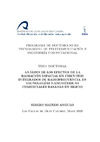Identificador persistente para citar o vincular este elemento:
https://accedacris.ulpgc.es/jspui/handle/10553/76593
| Título: | Análisis De Los Efectos De La Radiación Espacial En Circuitos Integrados De Radiofrecuencia En Tecnologías Nanométricas Comerciales Basadas En Silicio. | Otros títulos: | Radiation effects analysis of RF integrated circuits implemented in nanometric technologies based on silicon | Autores/as: | Mateos Angulo, Sergio | Director/a : | Del Pino Suárez, Francisco Javier | Clasificación UNESCO: | 3307 Tecnología electrónica | Fecha de publicación: | 2020 | Resumen: | Radiation tolerance in electronic circuits has become a relevant eld of study in the design of nanonelectronic systems. Speci cally, the analysis of the impact of radiation in circuits that compose wireless sensor networks (WSNs) has become of major importance. This type of network has changed the way of communicating, allowing the interconnection of a wide variety of devices and playing a major role in the development of the Internet of Things (IoT). However, there still exist certain applications in which the presence of high radiation discourages the use of this kind of network. Taking this into account, the development of devices that allow the deployment of WSNs in high radiation environments is seen as a hot topic in the eld of electronic systems. Speci cally, in aerospace applications, the use of WSNs would reduce the weight and volume of spacecrafts by reducing the wiring used for intra-satellite communications. This is of major importance, since it reduces the cost of launching the spacecrafts into space. The main issue in the use of WSNs in high radiation environments is how the circuits and electronic components are afected by the high energy ionizing particles present in this kind of environment. These particles can produce negative efects such as total ionizing dose (TID) or single event efects (SEEs). In order to mitigate the damages produced by TID and SEEs, there are several strategies that can be followed. One of them consists in using lightweight shielding. However, this shielding cannot fully prevent the ionizing particles from reaching the circuits. Furthermore, the use of this shielding will increase the weight of the spacecraft and, in turn, increase the cost of launching it into space. Another strategy is focused on the design of radiation hardened devices and circuits that are inherently robust against radiation. This dissertation follows this strategy and focuses on the design of radio-frequency (RF) circuits that are robust against radiation. In this case, radiation hardening by design (RHBD) techniques are employed. In this work, complementary metal-oxide-semiconductor (CMOS) technologies have been used to develop these circuits. These technologies represent a cost-efective solution when compared to III-V technologies, which are typically used in space applications. This cost reduction is achieved by using low cost devices with minimum size and weight, as well as operating at low power. However, CMOS technologies are vulnerable to radiation e ects, which means that designing radiation hardened circuits using these technologies can be stated as a challenging task. In order to achieve the goal of designing radiation hardened RF circuits, a thorough study of the efect of radiation in this type of circuit must be carried out. To do so, a complete analysis from the basic elements of RF circuits, which are the semiconductor devices, to complete RF systems is performed. | Descripción: | Programa de Doctorado en Tecnologías de Telecomunicación e Ingeniería Computacional por la Universidad de Las Palmas de Gran Canaria | Facultad: | Escuela de Ingeniería de Telecomunicación y Electrónica | URI: | https://accedacris.ulpgc.es/handle/10553/76593 |
| Colección: | Tesis doctoral |
Visitas
254
actualizado el 25-may-2024
Descargas
367
actualizado el 25-may-2024
Google ScholarTM
Verifica
Comparte
Exporta metadatos
Los elementos en ULPGC accedaCRIS están protegidos por derechos de autor con todos los derechos reservados, a menos que se indique lo contrario.
